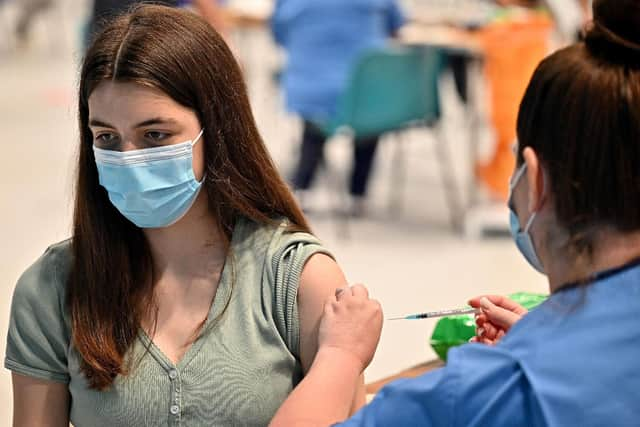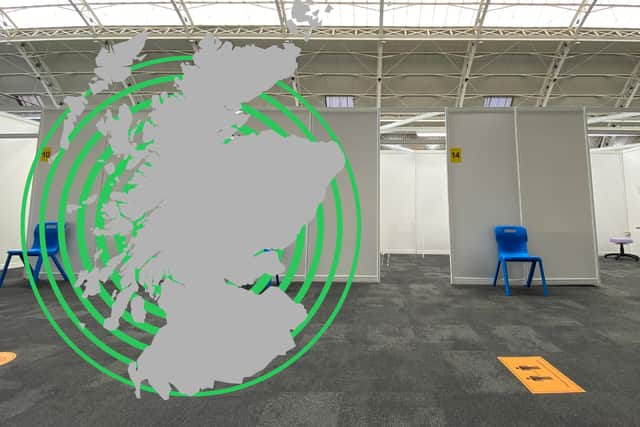Covid in Scotland: One in seven vaccine appointments have gone to waste with hundreds of thousands of no-shows
Figures obtained by The Scotsman reveal the scale of no-shows across the country, prompting concern from opposition parties about crucial vaccination targets being missed.
At least 360,000 vaccine slots went to waste from December last year to May, with patients failing to show up to one in seven appointments.
Advertisement
Hide AdAdvertisement
Hide AdIt comes as the Scottish Government has faced criticism for failing to meet its key jabs target for 40 to 49-year-olds.


Freedom of Information requests were sent to all 14 of Scotland’s health boards by The Scotsman asking how many appointments had been booked over the first five months of the vaccination programme, and how many patients had failed to attend.
Eight boards, including those covering the metropolitan areas of Glasgow and Edinburgh, were able to provide comparable figures.
They revealed that patients had failed to attend 360,760 of the 2,639,337 appointments booked – around one in seven. This included 31,155 no-shows for second jabs.


The figures are likely a vast underestimate, with six health boards unable to provide data.
Some of those that did could only report figures for part of the period from December 2020 to May 2021, or for appointments that were booked centrally, with no oversight on no-shows for those booked by GP surgeries.
Scottish Conservative shadow health secretary Annie Wells said the high rate of people not turning up for their appointments was “concerning” and claimed that many had struggled to gain access to jab centres in their own communities or they had not been open long enough.
Ms Wells said: “It is welcome that the success of the vaccination scheme has meant Scotland has eased further restrictions this week.
Advertisement
Hide AdAdvertisement
Hide Ad“However, we know that the SNP are still on course to fall well short of their own vaccination targets, including fully vaccinating all adults by September 12.”
Scottish Labour’s health and Covid recovery spokesperson Jackie Baillie said it was clear that vaccine hesitancy wasn’t the only issue when tens of thousands of second doses were being missed.
“Earlier in the programme we saw widespread reports of letters being sent to old addresses and difficulty rearranging appointments – all of which can lead to missed appointments,” Ms Baillie said.
“The SNP must fix these basic problems and ensure it is as easy as possible for everyone to get vaccinated at a time and place that suits them. We cannot afford to take our eye off the ball during this all-important final stretch.”
Greater Glasgow and Lothian health boards saw greatest number of no-shows
Breaking down the figures into health boards, the Greater Glasgow and Clyde and Lothian areas saw the greatest number of no-shows – 119,471 and 83,168 respectively.
Greater Glasgow was also worst affected by proportion of appointments missed, with a massive 20.5 per cent going to waste – more than one in five.
This was followed by Dumfries and Galloway (4,219 missed out of 25,396, or 16.6 per cent) and Grampian (51,150 out of 348,229, or 14.7 per cent).
NHS Greater Glasgow and Clyde pointed out that while there was no one single driving factor behind no-shows, some people may have missed their appointments because they went to a drop-in clinic instead.
Advertisement
Hide AdAdvertisement
Hide AdHowever, this means their slots at the permanent vaccine centres will still have gone unfilled.
The health board added: “The vaccination programme across NHS Greater Glasgow and Clyde has been hugely successful. The uptake has been extremely high and the did not attend (DNA) rate overall remains very low at just over one fifth.”
Meanwhile, NHS Lothian said it had experienced issues that were “unique” to the rest of Scotland, which had impacted its vaccination rates and caused no-shows, including the prevalence of students in the area.
Pat Wynne, director of community nursing at the health board, said: “Many of the younger people who are registered with a Lothian GP for vaccination are now living elsewhere and are unavailable for vaccination.
“Alongside this, we have greatly expanded our drop-in vaccination provision, enabling people to receive their vaccination at a time and location that is convenient to them. We know lots of people are choosing this option.”
Several health boards said they could only provide data on appointments booked using the National Vaccination Scheduling System (NVSS), Scotland’s centralised invitation management system.
Some only began using the system part-way through the year, with no data collected on any appointments booked by local teams such as GPs before that.
A Scottish Government spokesperson said: “Scotland’s vaccination programme is an overwhelming success and is one of the fastest vaccination programmes anywhere in the world. As of August 12, we have vaccinated 90 per cent of adults aged 18 and over with first doses and 76 per cent with second doses.
Advertisement
Hide AdAdvertisement
Hide Ad“While a small number of individuals may choose not to attend their scheduled appointment, some people may be unable to attend at a set time and will be vaccinated at a later date.
“We are working to make it as simple as possible for people, particularly those in younger age groups, to get their vaccines. We are increasing the options available for how and when people choose to be vaccinated, including drop-in mobile centres, which have visited a range of sites such as football grounds, parks, workplaces and shopping centres.”
Comments
Want to join the conversation? Please or to comment on this article.
